Optimization of Laser Powder Bed Fusion Process for Forming Porous Ta Scaffold
Abstract
:1. Introduction
2. Material and Methods
2.1. Microstructure Design of Porous Ta Scaffold
2.2. Materials
2.3. L-PBF Equipment
2.4. L-PBF Process of Porous Ta Scaffolds
2.5. Porosity Measurement and Porous Structure Characterization
2.6. Compressive Mechanical Property Test
2.7. Statistical Analysis Method
3. Results and Discussions
3.1. Microstructure Characterization
3.2. Compressive Mechanical Properties
3.3. Statistical Results on the Influence of L-PBF Parameters on the Forming Quality
3.3.1. Range Analysis Results
3.3.2. Variance Analysis Results
3.4. Porous Ta Morphology and Mechanical Properties with Optimal Process Parameters
4. Conclusions
Author Contributions
Funding
Data Availability Statement
Acknowledgments
Conflicts of Interest
References
- Wauthle, R.; van der Stok, J.; Yavari, S.A.; Humbeeck, J.V.; Kruth, J.P.; Zadpoor, A.A.; Weinans, H.; Mulier, M.; Schrooten, J. Additively manufactured porous tantalum implants. Acta Biomater. 2015, 14, 217–225. [Google Scholar] [CrossRef] [PubMed]
- Gao, H.; Jin, X.; Yang, J.; Zhang, D.; Zhang, S.; Zhang, F.; Chen, H. Porous structure and compressive failure mechanism of additively manufactured cubic-lattice tantalum scaffolds. Mater. Today Adv. 2021, 12, 100183. [Google Scholar] [CrossRef]
- Dong, C.; Bi, X.L.; Yu, J.G.; Liu, R.; Zhang, Q.X. Microstructural evolution and sintering kinetics during spark plasma sintering of pure tantalum powder. J. Alloys Compd. 2019, 781, 84–92. [Google Scholar] [CrossRef]
- Balla, V.K.; Bodhak, S.; Bose, S.; Bandyopadhyay, A. Porous tantalum structures for bone implants: Fabrication, mechanical and in vitro biological properties. Acta Biomater. 2010, 6, 3349–3359. [Google Scholar] [CrossRef]
- Fernandez-Fairen, M.; Querales, V.; Jakowlew, A.; Murcia, A.; Ballester, J. Tantalum is a good bone graft substitute in tibial tubercle advancement. Clin. Orthop. Relat. Res. 2010, 468, 1284–1295. [Google Scholar] [CrossRef]
- Liu, Y.; Bao, C.; Wismeijer, D.; Wu, G. The physicochemical/biological properties of porous tantalum and the potential surface modification techniques to improve its clinical application in dental implantology. Mater. Sci. Eng. C 2015, 49, 323–329. [Google Scholar] [CrossRef]
- Wang, Q.; Zhang, H.; Li, Q.J.; Ye, L.; Gan, H.Q.; Liu, Y.J.; Wang, H.; Wang, Z.Q. Biocompatibility and osteogenic properties of porous tantalum. Exp. Ther. Med. 2015, 9, 780–786. [Google Scholar] [CrossRef]
- Gracia, M.A.A. Osseoincorporation of porous tantalum trabecular-structured metal: A histologic and histomorphometric study in humans. Int. J. Periodontics Restor. Dent. 2018, 38, 879–885. [Google Scholar]
- Dou, X.J.; Wei, X.W.; Liu, G.; Wang, S.; Lv, Y.X.; Li, J.L.; Ma, Z.J.; Zheng, G.S.; Wang, Y.K.; Hu, M.H.; et al. Effect of porous tantalum on promoting the osteogenic differentiation of bone marrow mesenchymal stem cells in vitro through the MAPK/ERK signal pathway. J. Orthop. Transl. 2019, 19, 81–93. [Google Scholar] [CrossRef]
- Guo, Y.; Xie, K.; Jiang, W.B.; Wang, L.; Li, G.Y.; Zhao, S.; Wu, W.; Hao, Y.Q. In vitro and in vivo study of 3D-printed porous tantalum scaffolds for repairing bone defects. ACS Biomater. Sci. Eng. 2019, 5, 1123–1133. [Google Scholar]
- Piglionico, S.; Bousquet, J.; Fatima, N.; Renaud, M.; Collart-Dutilleul, P.-Y.; Bousquet, P. Porous tantalum VS. Titanium implants: Enhanced mineralized matrix formation after stem cells proliferation and differentiation. J. Clin. Med. 2020, 9, 3657. [Google Scholar] [CrossRef]
- Jia, C.Q.; Zhang, Z.; Cao, S.Q.; Wang, T.J.; Yu, H.C.; Wang, W.X.; Guo, B.M.; Qiu, X.Y.; You, Y.G.; Hu, F.Q.; et al. A biomimetic gradient porous cage with a micro-structure for enhancing mechanical properties and accelerating osseointegration in spinal fusion. Bioact. Mater. 2023, 23, 234–246. [Google Scholar] [CrossRef]
- Zhao, D.W.; Ma, Z.J.; Wang, T.N.; Liu, B.Y. Biocompatible porous tantalum metal plates in the treatment of tibial fracture. Orthop. Surg. 2019, 11, 325–329. [Google Scholar] [CrossRef]
- Sagherian, B.H.; Claridge, R.J. The use of tantalum metal in foot and ankle surgery. Orthop. Clin. N. Am. 2019, 50, 119–129. [Google Scholar] [CrossRef]
- Zhou, L.; Yuan, T.; Li, R.; Tang, J.; Wang, G.; Guo, K. Selective laser melting of pure tantalum: Densification, microstructure and mechanical behaviors. Mater. Sci. Eng. A 2017, 707, 443–451. [Google Scholar] [CrossRef]
- Bartolomeu, F.; Faria, S.; Carvalho, O.; Pinto, E.; Alves, N.; Silva, F.S.; Miranda, G. Predictive Models for physical and mechanical properties of ti6al4v produced by selective laser melting. Mater. Sci. Eng. A 2016, 663, 181–192. [Google Scholar] [CrossRef]
- Miranda, G.; Faria, S.; Bartolomeu, F.; Pinto, E.; Madeira, S.; Mateus, A.; Carreira, P.; Alves, N.; Silva, F.S.; Carvalho, O. Predictive models for physical and mechanical properties of 316l stainless steel produced by selective laser melting. Mater. Sci. Eng. A 2016, 657, 43–56. [Google Scholar] [CrossRef]
- Huang, S.; Sing, S.L.; de Looze, G.; Wilson, R.; Yeong, W.Y. Laser powder bed fusion of titanium-tantalum alloys: Compositions and designs for biomedical applications. J. Mech. Behav. Biomed. Mater. 2020, 108, 103775. [Google Scholar] [CrossRef]
- Tang, H.P.; Yang, K.; Jia, L.; He, W.W.; Yang, L.; Zhang, X.Z. Tantalum bone implants printed by selective electron beam manufacturing (SEBM) and their clinical applications. JOM 2020, 72, 1016–1021. [Google Scholar] [CrossRef]
- Ghouse, S.; Babu, S.; Nai, K.; Hooper, P.A.; Jeffers, J.R.T. The influence of laser parameters, scanning strategies and material on the fatigue strength of a stochastic porous structure. Addit. Manuf. 2018, 22, 290–301. [Google Scholar] [CrossRef]
- Song, C.; Deng, Z.; Zou, Z.; Liu, L.; Xu, K.; Yang, Y. Pure tantalum manufactured by laser powder bed fusion: Influence of scanning speed on the evolution of microstructure and mechanical properties. Int. J. Refract. Met. Hard Mater. 2022, 107, 105882. [Google Scholar] [CrossRef]
- Livescu, V.; Knapp, C.M.; Gray, G.T.; Martinez, R.M.; Morrow, B.M.; Ndefru, B.G. Additively manufactured tantalum microstructures. Materialia 2018, 1, 15–24. [Google Scholar] [CrossRef]
- Băb, A.M.; Timu, D.; Sori, O.; Bo, B.A.; Barabas, R.; Ionel, A.; Petrescu, N.B.; Feurdean, C.N.; Bordea, I.R.; Saraci, G.; et al. Tissue integration and biological cellular response of SLM-manufactured titanium scaffolds. Metals 2020, 10, 1192. [Google Scholar]
- Huang, S.; Zhang, X.; Li, D.; Li, Q. Microstructure and mechanical properties of b-bearing austenitic stainless steel fabricated by laser metal deposition in-situ alloying. Acta Metall. Sin. (Engl. Lett.) 2022, 35, 453–465. [Google Scholar] [CrossRef]
- Chen, X.; Sun, G.; Zhu, J.; Kang, W.; Shang, D.; Deng, Z. Influence of structural parameters on mechanical properties of triply periodic minimal surface structure. Metals 2023, 13, 285. [Google Scholar] [CrossRef]
- ISO 13314; Mechanical testing of metals—Ductility testing—Compression test for porous and cellular metals. ISO Central Secretariat: Geneva, Switzerland, 2011.
- Antony, K.; Arivazhagan, N.; Senthilkumaran, K. Numerical and experimental investigations on laser melting of stainless steel 316L metal powders. J. Manuf. Process. 2014, 16, 345–355. [Google Scholar] [CrossRef]
- Khorasani, A.M.; Gibson, I.; Ghasemi, A.; Ghaderi, A. A Comprehensive Study on Variability of Relative Density in Selective Laser Melting of Ti-6Al-4V. Virtual Phys. Prototyp. 2019, 14, 349–359. [Google Scholar] [CrossRef]
- Rana, R.S.; Rajesh, P.; Mishra, P.M.; Sahu, P.; Dwivedi, S. Shailendra. Optimization of mechanical properties of AA 5083 nano SiC composites using design of experiment technique. Mater. Today Proc. 2017, 4, 3882–3890. [Google Scholar] [CrossRef]
- Zhao, G.B.; Li, S.S.; Chen, X.; Qu, X.L.; Chen, R.M.; Wu, Y.L.; Liu, Y.X.; Zou, X.L.; Lu, X.G. Porous tantalum scaffold fabricated by gel casting based on 3D printing and electrolysis. Mater. Lett. 2019, 239, 5–8. [Google Scholar] [CrossRef]
- Su, K.X.; Ji, P.; Wang, H.; Li, L.L.; Su, L.Z.; Wang, C. In vivo study of 3D printed porous tantalum implant on osseointegration. West China J. Stomatol. 2018, 36, 291–295. [Google Scholar]
- Jiao, J.Y.; Hong, Q.M.; Zhang, D.C.; Wang, M.Q.; Tang, H.Z.; Yang, J.Z.; Qu, X.H.; Yue, B. Influence of porosity on osteogenesis, bone growth and osteointegration in trabecular tantalum scaffolds fabricated by additive manufacturing. Front. Bioeng. Biotechnol. 2023, 11, 1117954. [Google Scholar] [CrossRef] [PubMed]
- Gao, R.N.; Xiong, Y.Z.; Zhang, H.; Dong, L.L.; Li, J.T.; Li, X. Mechanical properties and biocompatibilities of radially graded porous titanium/tantalum fabricated by selective laser melting. Rare Met. Mater. Eng. 2021, 50, 249–254. [Google Scholar]
- Chen, W.L.; Yang, J.Z.; Kong, H.; Helou, M.; Zhang, D.C.; Zhao, J.H.; Jia, W.T.; Liu, Q.; He, P.D.; Li, X.P. Fatigue behaviour and biocompatibility of additively manufactured bioactive tantalum graded lattice structures for load-bearing orthopaedic applications. Mater. Sci. Eng. C 2021, 130, 112461. [Google Scholar] [CrossRef] [PubMed]
- Fan, H.Q.; Deng, S.; Tang, W.T.; Muheremu, A.; Wu, X.Z.; He, P.; Tan, C.H.; Wang, G.H.; Tang, J.Z.; Guo, K.X. Highly porous 3D printed tantalum scaffolds have better biomechanical and microstructural properties than titanium scaffolds. BioMed Res. Int. 2021, 2021, 1–8. [Google Scholar] [CrossRef]
- Zhang, T.M.; Chen, C.; Dong, J.; Wu, Y.Y.; Qian, H.; Lei, T.; Lei, P.F.; Zhou, K.C. Microstructure and biocompatibility of porous-Ta/Ti-6Al-4 V component produced by laser powder bed fusion for orthopedic implants. Mater. Charact. 2021, 182, 111554. [Google Scholar] [CrossRef]
- Guo, Y.; Chen, C.; Wang, Q.B.; Liu, M.; Cao, Y.K.; Pan, Y.M.; Tan, L.M. Effect of porosity on mechanical properties of porous tantalum scaffolds produced by electron beam powder bed fusion. Trans. Nonferrous Met. Soc. China 2022, 32, 2922–2934. [Google Scholar] [CrossRef]
- Li, H.J.; Yang, G.L.; Lv, S.J.; Zhou, Q.; Fan, L.S.; Liu, R.; Yao, J.H.; Tong, P.J. Effects of unit cell topology on the mechanical propeties of porous tantalum structures via laser powder bed fusion. Adv. Eng. Mater. 2023, 25, 2201431. [Google Scholar] [CrossRef]
- Thijs, L.; Sistiaga, M.L.M.; Wauthle, R.; Xie, Q.G.; Kruth, J.P.; Humbeeck, J.V. Strong morphological and crystallographic texture and resulting yield strength anisotropy in selective laser melted tantalum. Acta Mater. 2013, 61, 4657–4668. [Google Scholar] [CrossRef]
- Wu, X.; Luo, K.; Wang, Q.; Liu, H.; Wang, F.; Wang, P.; Lan, J. Study on the influence of forming Parameters of laser selective melting tantalum metal on its density and defects. Laser J. 2019, 41, 8–14. [Google Scholar]



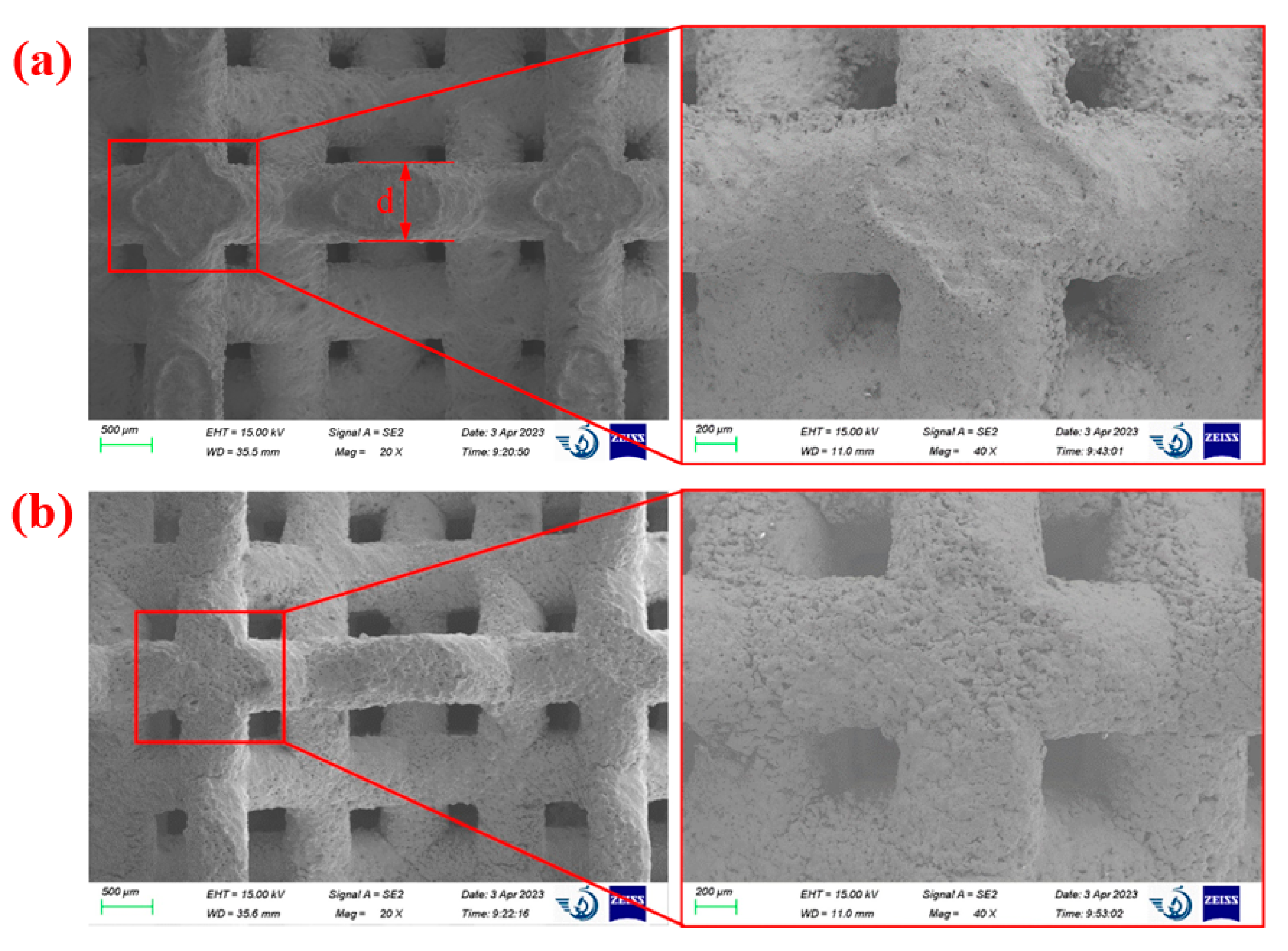
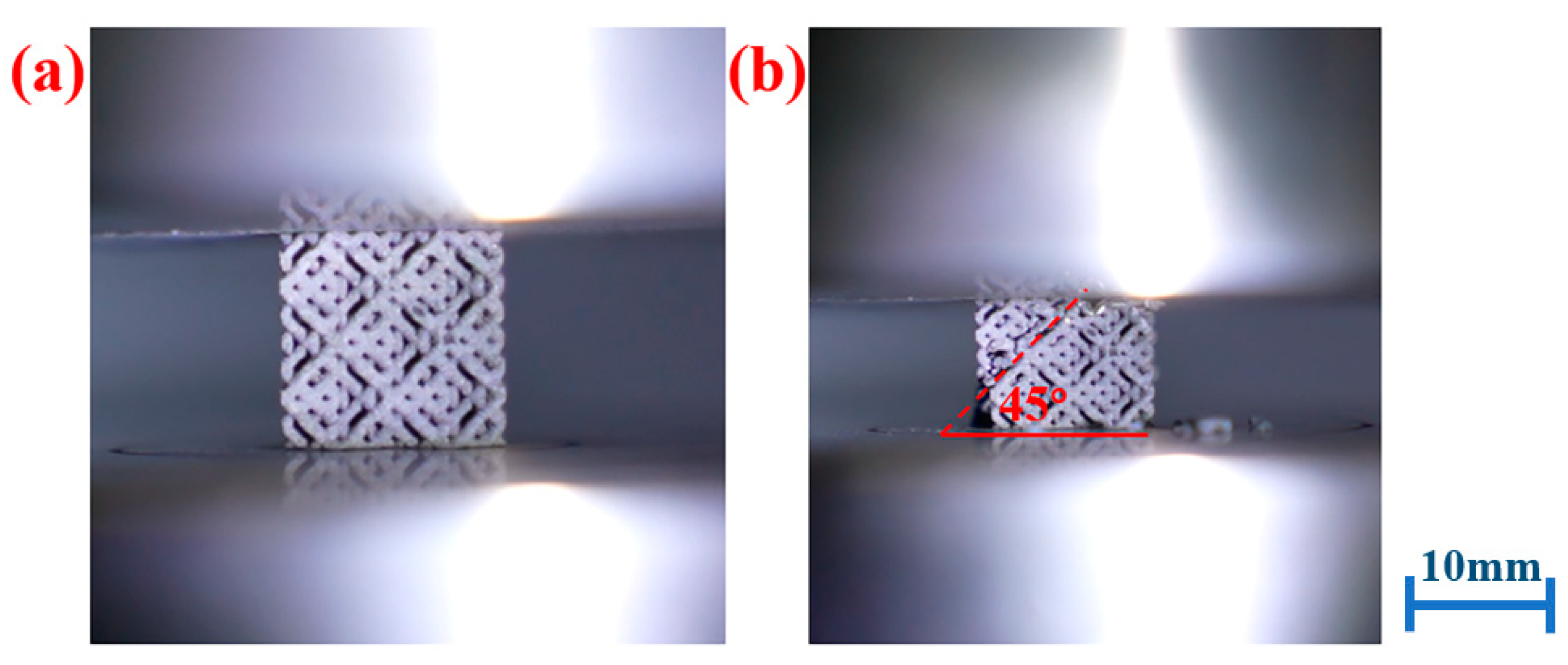

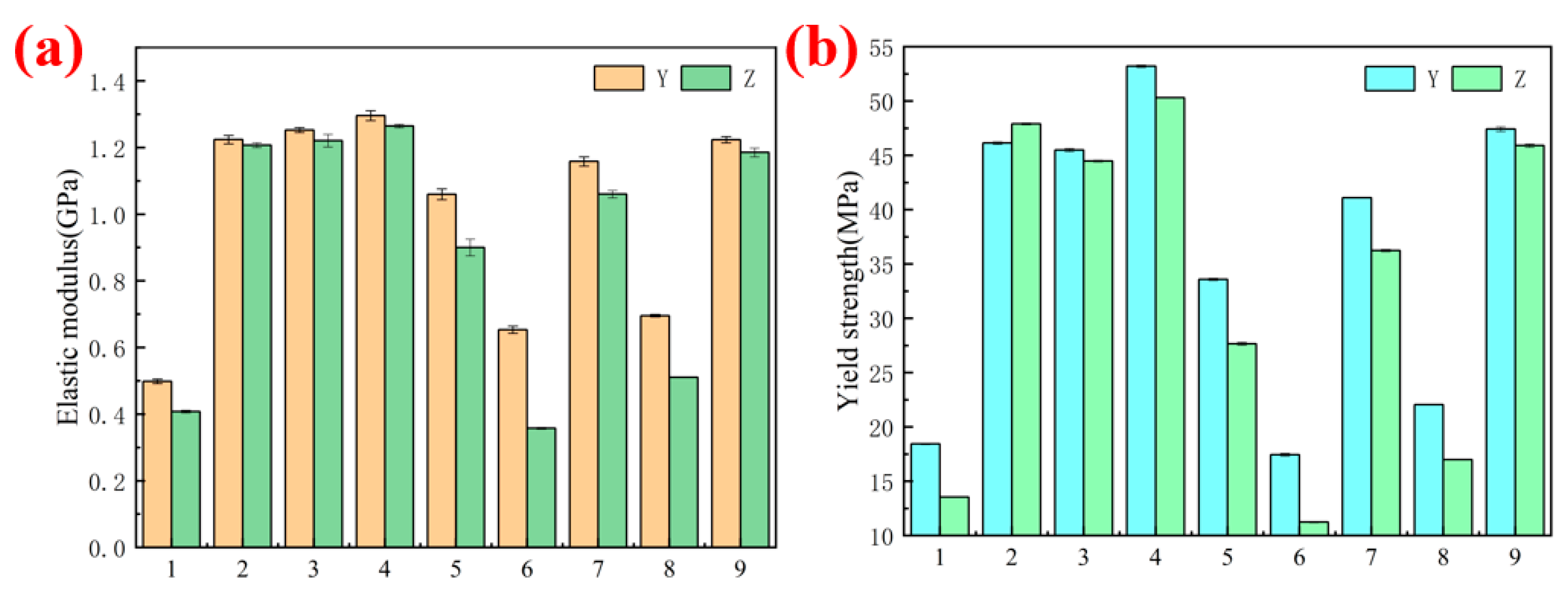
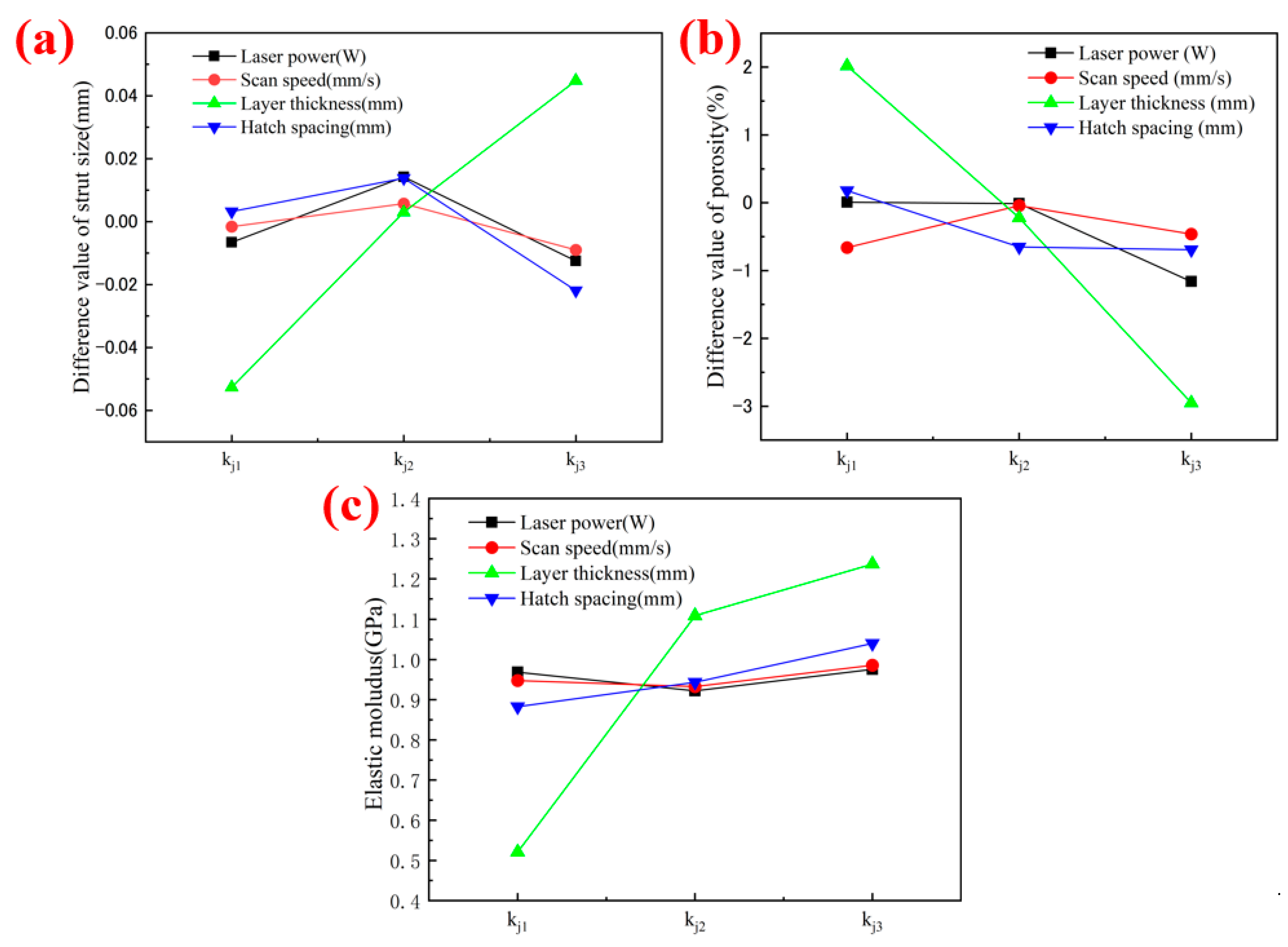

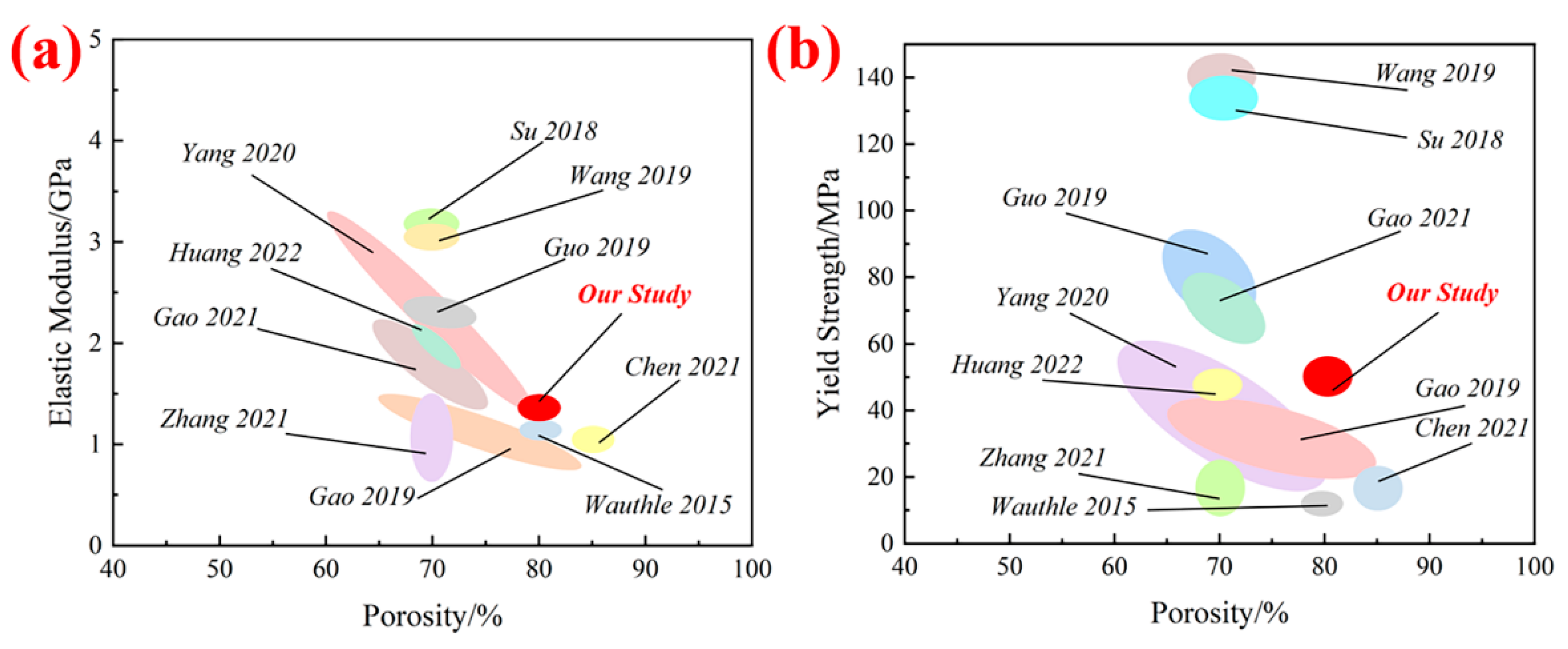
| Element | O | C | N | H | Fe | Ni | Ti | Ta |
|---|---|---|---|---|---|---|---|---|
| Standard values | ≤0.03 | ≤0.01 | ≤0.01 | ≤0.015 | ≤0.03 | ≤0.01 | ≤0.01 | Balance |
| Measured values | 0.02 | 0.0088 | <0.001 | <0.0015 | <0.01 | 0.0016 | 0.001 | Balance |
| Number | Laser Power (W) | Scanning Speed (mm/s) | Thickness (mm) | Scan Spacing (mm) |
|---|---|---|---|---|
| 1 | 120 | 270 | 0.03 | 0.05 |
| 2 | 120 | 300 | 0.05 | 0.06 |
| 3 | 120 | 330 | 0.04 | 0.07 |
| 4 | 150 | 270 | 0.05 | 0.07 |
| 5 | 150 | 300 | 0.04 | 0.05 |
| 6 | 150 | 330 | 0.03 | 0.06 |
| 7 | 180 | 270 | 0.04 | 0.06 |
| 8 | 180 | 300 | 0.03 | 0.07 |
| 9 | 180 | 330 | 0.05 | 0.05 |
| Number | 1 | 2 | 3 | 4 | 5 | 6 | 7 | 8 | 9 |
|---|---|---|---|---|---|---|---|---|---|
| Porosity (%) | 82.7 ± 0.061 | 77.5 ± 0.012 | 79.8 ± 0.025 | 76.9 ± 0.020 | 81.1 ± 0.040 | 82.1 ± 0.035 | 78.5 ± 0.012 | 81.3 ± 0.181 | 76.8 ± 0.012 |
| Strut diameter in building direction (μm) | 699.1 ± 4.384 | 783.7 ± 0.071 | 740.5 ± 1.626 | 797.1 ± 2.051 | 769.8 ± 2.758 | 724.0 ± 1.980 | 798.7 ± 10.112 | 752.8 ± 2.051 | 783.1 ± 13.223 |
| Strut diameter in horizontal direction (μm) | 782.4 ± 6.131 | 828.2 ± 2.864 | 846.9 ± 7.085 | 892.7 ± 7.000 | 877.4 ± 7.693 | 841.9 ± 9.659 | 856.5 ± 3.514 | 861.1 ± 7.311 | 861.6 ± 5.537 |
| Process Parameters | Laser Power (A) | Scanning Speed (B) | Thickness © | Scanning Spacing (D) |
|---|---|---|---|---|
| kj1 | 0.7606 | 0.7847 | 0.7511 | 0.7731 |
| kj2 | 0.7904 | 0.7905 | 0.7923 | 0.7871 |
| kj3 | 0.7986 | 0.7744 | 0.8062 | 0.7893 |
| Rj | 0.0380 | 0.0161 | 0.0551 | 0.0162 |
| Process Parameters | Laser Power | Scanning Speed | Thickness | Scanning Spacing |
|---|---|---|---|---|
| kj1 | 0.8001 | 0.7934 | 0.8202 | 0.8018 |
| kj2 | 0.7999 | 0.7996 | 0.7978 | 0.7935 |
| kj3 | 0.7884 | 0.7954 | 0.7705 | 0.7931 |
| Rj | 0.0118 | 0.0062 | 0.0497 | 0.0086 |
| Process Parameters | Laser Power | Scanning Speed | Thickness | Scanning Spacing |
|---|---|---|---|---|
| kj1 | 0.9687 | 0.9477 | 0.5210 | 0.8828 |
| kj2 | 0.9222 | 0.9330 | 1.1087 | 0.9435 |
| kj3 | 0.9758 | 0.9860 | 1.2370 | 1.0403 |
| Rj | 0.0537 | 0.0530 | 0.7160 | 0.1575 |
| Source | Sum of Deviation Squares | Degree of Freedom | Mean Square Deviation | F Value | Significance Level | Contribution |
|---|---|---|---|---|---|---|
| Laser power | 0.007 | 2 | 0.004 | 95.023 | (*) | 14.14% |
| Scanning speed | 0.004 | 2 | 0.002 | 49.943 | 7.36% | |
| Thickness | 0.033 | 2 | 0.017 | 432.657 | * | 64.91% |
| Scanning spacing | 0.006 | 2 | 0.003 | 78.424 | (*) | 11.64% |
| Error | 0.001 | 18 | 0.000 | 1.95% |
| Source | Sum of Deviation Squares | Degree of Freedom | Mean Square Deviation | F Value | Significance Level | Contribution |
|---|---|---|---|---|---|---|
| Laser power | 0.001 | 2 | 0.000 | 1366.238 | 6.51% | |
| Scanning speed | 0.000 | 2 | 0.000 | 301.976 | 1.43% | |
| Thickness | 0.011 | 2 | 0.006 | 18,592.609 | * | 88.60% |
| Scanning spacing | 0.000 | 2 | 0.000 | 709.876 | 3.38% | |
| Error | 0.00001 | 27 | 0.00000 | 0.08% |
| Source | Sum of Deviation Squares | Degree of Freedom | Mean Square Deviation | F Value | Significance Level | Contribution |
|---|---|---|---|---|---|---|
| Thickness | 1.749 | 2 | 0.875 | 108.624 | * | 89.82% |
| Other sources | 0.076 | 2 | 0.038 | 4.703 | 3.09% | |
| Error | 0.105 | 13 | 0.008 | 7.09% |
| L-PBF Process | Porosity/% | Strut Diameter/mm | Elastic Modulus/GPa | ||
|---|---|---|---|---|---|
| Horizontal Direction | Building Direction | Horizontal Direction | Building Direction | ||
| Group 4 (150 W, 270 mm/s, 0.05 mm, 0.07 mm) | 75.11 ± 0.11 | 0.892 ± 0.014 | 0.797 ± 0.012 | 1.296 ± 0.015 | 1.265 ± 0.006 |
| Optimized process (180 W, 270 mm/s, 0.05 mm, 0.07 mm) | 74.00 ± 0.13 | 0.857 ± 0.009 | 0.803 ± 0.010 | 1.352 ± 0.007 | 1.298 ± 0.006 |
Disclaimer/Publisher’s Note: The statements, opinions and data contained in all publications are solely those of the individual author(s) and contributor(s) and not of MDPI and/or the editor(s). MDPI and/or the editor(s) disclaim responsibility for any injury to people or property resulting from any ideas, methods, instructions or products referred to in the content. |
© 2023 by the authors. Licensee MDPI, Basel, Switzerland. This article is an open access article distributed under the terms and conditions of the Creative Commons Attribution (CC BY) license (https://creativecommons.org/licenses/by/4.0/).
Share and Cite
Gao, L.; Wang, Y.; Qin, X.; Lv, N.; Tong, Z.; Sun, C.; Li, D. Optimization of Laser Powder Bed Fusion Process for Forming Porous Ta Scaffold. Metals 2023, 13, 1764. https://doi.org/10.3390/met13101764
Gao L, Wang Y, Qin X, Lv N, Tong Z, Sun C, Li D. Optimization of Laser Powder Bed Fusion Process for Forming Porous Ta Scaffold. Metals. 2023; 13(10):1764. https://doi.org/10.3390/met13101764
Chicago/Turabian StyleGao, Lin, Yikai Wang, Xiao Qin, Naixin Lv, Zhiqiang Tong, Changning Sun, and Dichen Li. 2023. "Optimization of Laser Powder Bed Fusion Process for Forming Porous Ta Scaffold" Metals 13, no. 10: 1764. https://doi.org/10.3390/met13101764




